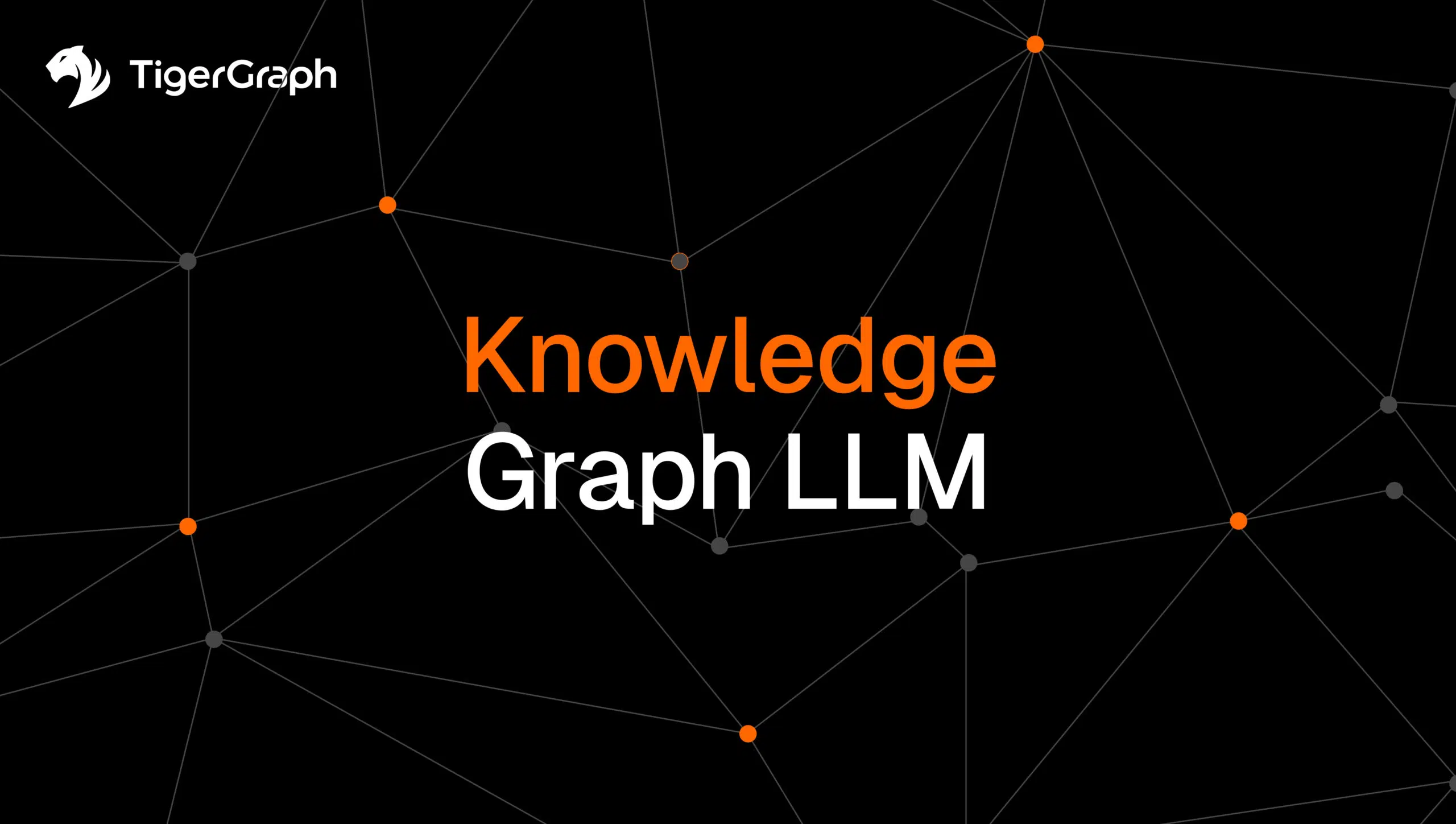Reducing AI Hallucinations: Why LLMs Need Knowledge Graphs for Accuracy
Every AI leader wants helpful assistants, not confident liars. Large language models (LLMs) are powerful, but without guardrails, they hallucinate, improvise sources, and miss context across systems. Pairing LLMs and knowledge graphs fixes that gap.
This architecture turns raw generation into grounded reasoning: the model retrieves facts from governed data, understands graph relationships, and explains its answers. The result is higher accuracy, faster time-to-value, and AI you can show to customers, auditors, and boards with confidence.
What Is a Knowledge Graph LLM (and Why It Matters)?
A knowledge graph LLM connects an LLM to a graph of entities and relationships—customers, accounts, devices, suppliers, or policies, so the model consults authoritative facts before it writes.
The database stores nodes (entities) and edges (relationships) with timestamps and lineage. At runtime, it performs retrieval to fetch relevant paths, then generates an answer grounded in those facts.
The LLM and knowledge graph pairing blends creativity with certainty. It extracts fluency from the model and accuracy from the graph.
In practice, this means your teams can:
- Answer complex, multi-hop questions and cite sources.
- Enforce data governance by restricting what content the LLM may use.
- Provide path-level evidence for every claim (who, what, when, how), directly from the database.
- Scale copilots, ensuring consistency across business units.
This is why leaders exploring how to reduce AI hallucinations with knowledge graphs quickly see it’s less about experimentation and more about operational necessity.
Why LLMs Alone Aren’t Enough for the Enterprise
LLMs learn patterns, not truth. Left unchecked, they:
- Hallucinate plausible but wrong facts.
- Ignore relationships across silos (people→accounts→devices→transactions).
- Lack explainability, offering no lineage when auditors ask, “Where did this come from?”
For regulated industries, that’s unacceptable. LLMs and knowledge graphs solve this by grounding output in governed data and exposing the graph paths behind every answer.
When accuracy, provenance, and policy compliance matter, a knowledge graph LLM is the operating model. For executives, the key question is how to combine knowledge graphs with LLMs for accuracy, and how to do it quickly, so you can deploy them at scale.
How Knowledge Graphs and LLMs Work Together (Architecture at a Glance)
Two proven patterns dominate enterprise deployments:
1. Graph-Augmented Retrieval (GAR)—Ideal for audits where evidence trails are mandatory.
- The LLM issues a retrieval query to the LLM graph database.
- The graph returns entities, edges, and subgraphs (with timestamps/lineage).
- The LLM composes an answer citing the graph results.
Enterprise example: A compliance officer asks, “Which beneficial owners are tied to this account across three jurisdictions?” The GAR approach lets the LLM retrieve the exact subgraph showing entities, addresses, and corporate registrations. Instead of guessing, the model cites the connected path with dates and ownership edges intact.
2. Graph-Constrained Generation (GCG)—Ideal when you need strict compliance, consistency, and governance.
- The LLM is constrained to use only facts returned by the pipeline.
- Policies and access controls filter content at retrieval time.
Enterprise example: A customer chatbot fields a loan-eligibility question. With GCG, the LLM is restricted to the governed eligibility rules stored in the LLM graph database. The assistant explains “yes/no” decisions with reference to actual policy nodes, never inventing conditions.
Why this helps: The graph LLM pipeline bakes in governance, speed, and context. You get lower hallucination rates, consistent terminology, and answers you can defend in front of regulators.
What a Knowledge Graph and LLM Adds (Compared to Plain LLM)
| Capability | Plain LLM | LLM Knowledge Graph |
|---|---|---|
| Grounding | Pattern guesses | Factual retrieval from governed database |
| Context | Limited hops | Full multi-hop + temporal context |
| Explainability | No source trails | Path-level lineage for audits |
| Governance | Prompt rules only | Schema/RBAC enforced at retrieval |
| Latency | Variable | Sub-ms graph traversal on targeted paths |
| Reliability | Inconsistent | Stable outputs aligned to enterprise truth |
With this design, the assistant cites exactly which entities and edges informed its response, enabling deployments that are trustworthy and repeatable.
Enterprise Use Cases for LLMs and Knowledge Graphs
Financial Crime & Risk
- Knowledge graph question answering links customers, devices, merchants, and transactions.
- Analysts pivot on explorable paths; models ingest graph-native features like proximity to risk.
- Outcome: explainable alerts, stronger AML/KYC, fewer escalations.
- This approach reuses TigerGraph-proven capabilities where banks achieved 20% higher fraud detection, 300% faster investigations, and >$100M annual savings.
- Example: A fraud analyst investigating mule networks asks, “Which accounts are two hops away from this known mule?” An LLM knowledge graph instantly surfaces the connected accounts and devices, dramatically cutting investigation time.
Customer & Employee Assistants
- Product Q&A grounded in contracts, SKUs, entitlements—no guessing.
- Policy copilots reason over procedures and approvals via graph edges.
- Deflection improves, responses stay within governed content.
- Example: An HR assistant built with a knowledge graph LLM architecture cites the official PTO workflow, shows approvers by role, and pulls historical approvals—all from governed graph data. The LLM never improvises, saving HR teams hundreds of hours.
Ops & Supply Chain
- Supplier dependencies, routes, and constraints are stored in the LLM graph database.
- Assistants answer, “What fails if supplier X fails?” with multi-hop reasoning.
- Results reflect reality across plants, parts, and logistics.
- Example: A supply chain planner queries: “If our Tier 2 supplier in Taiwan is disrupted, which customers are impacted downstream?” The LLM and knowledge graph returns the entire ripple path across suppliers, factories, and customers—evidence executives can act on.
Healthcare & Life Sciences
- Trials, diagnoses, procedures, and outcomes are modeled as a graph.
- LLM and knowledge graph outputs evidence-based summaries with lineage.
- Outcome: fewer duplicate tests, improved patient care, and regulator-ready reporting.
- Example: A case manager asks, “Which patients share overlapping treatment histories and risks?” The LLM with knowledge graph identifies clusters and cites lineage, reducing errors and enabling proactive care.
TigerGraph’s Advantage for LLM Graph Database
Not every platform can operationalize this insight at enterprise scale. TigerGraph is engineered for production, combining real-time speed with deep analytics:
- Speed for UX: Sub-ms traversal on multi-hop queries keeps chat responses crisp even when multiple users query complex paths simultaneously.
- Scale with change: Sustains ~50M daily events so the graph LLM stays current as payments, contracts, or policies stream in. Latency doesn’t spike as volume grows.
- Explainability: Path-level lineage (who/what/when/how) delivers regulator-ready outputs with timestamps and sources.
- Model features: Graph signals, including community membership, centrality, time-bounded fan-in/fan-out to improve rankers, guardrails, and classifiers. Features stream directly into ML pipelines.
- Security & governance: Schema-first modeling + RBAC ensures the LLM knowledge graph uses only governed data, never uncontrolled text.
- Proven outcomes: In adjacent fraud/AML, TigerGraph customers report 20% detection lift, 300% faster investigations, and >$100M annual savings—evidence that the same platform can support explainable AI at scale.
Implementation Playbook: LLM and Knowledge Graph in 7 Steps
- Define truth sources. Ingest contracts, policies, KYC/AML, and product catalogs into the LLM graph database. Why it matters: Establishes the ground truth your AI must never contradict.
- Model entities/edges. Customers, devices, approvals; add timestamps + lineage. Why it matters: Without lineage, answers can’t be defended in audits.
- Choose retrieval pattern. GAR for flexibility; GCG for stricter governance. Why it matters: Pick the mode that matches your risk profile.
- Enrich with graph features. Proximity to risk, communities, fan-in/fan-out to guide LLM outputs. Why it matters: Features improve recall and reduce false positives.
- Add guardrails. Grounding checks, policy filters, and allowlists for both. Why it matters: Prevents hallucination and enforces compliance at runtime.
- Measure & iterate. Track accuracy, deflection, latency, citation coverage. Why it matters: Keeps your data stable over time.
- Monitor observability & SLAs. Detect retrieval misses, drift, or degraded latency before they hurt adoption. Why it matters: Ensures executives can trust the assistant in production.
Metrics That Matter (for Executives)
- Answer accuracy vs. ground truth.
- Citation coverage (% of answers with graph-backed evidence).
- Deflection rate (tasks completed without humans).
- Latency (P95 incl. graph retrieval).
- Audit readiness (path lineage available on demand).
- Governed knowledge graph for LLM compliance tests.
FAQ: Quick Answers on Knowledge Graphs and LLMs
Is a warehouse enough?
Warehouses store facts; a relationship graph preserves connections. An LLM and a knowledge graph use those links to reason multi-hop with lineage.
Do I need fine-tuning?
Often no. It grounds a base model via retrieval, reducing costly fine-tuning.
What about PII/access?
Schema-level RBAC ensures the graph only returns authorized data.
How do I show explainability?
Export timestamped paths that regulators can follow.
Trends and Pitfalls in Knowledge Graph LLM Adoption
Enterprises experimenting with this combination often begin with small pilots, which means limited datasets, narrow use cases, and minimal governance. The pitfall is leaving the effort at the proof-of-concept stage, where outputs remain brittle and adoption stalls.
Leaders are now moving beyond pilots to production: scaling ingestion to handle millions of daily events, modeling lineage for every edge, and enforcing policy controls so the knowledge graph LLM becomes the default retrieval layer for AI. This shift transforms prototypes into enterprise assets, delivering higher accuracy, faster time-to-value, and stronger executive trust.
Conclusion
Hallucination-free AI requires more than prompts. It requires a foundation of facts and relationships. This pairing turn creativity into credibility, with grounded answers, clear lineage, and enterprise governance.
With TigerGraph, you get sub-ms traversal, ~50M/day streaming scale, and audit-ready paths—capabilities already delivering 20% detection lift, 300% faster investigations, and >$100M annual savings in adjacent fraud/AML programs.
That same foundation is how you combine knowledge graphs with LLMs for accuracy and build AI that your customers and regulators can trust. Reach out today to learn more about it!

